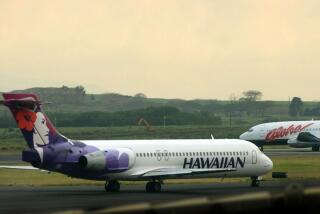Market Watch : Playing on HAL Seesaw
- Share via
The tale of HAL Inc., the beleaguered holding company for Hawaiian Airlines, is a good lesson for anyone who wants to play thinly traded, rumor-buffeted stocks: You’re probably better off with the horses at Santa Anita, but if you really love excitement and have money to blow, trading a stock like HAL is a perfect diversion.
If you would have regularly bought and sold HAL stock during the past decade at just the right times, you could have made 50% to 100% almost yearly. There aren’t too many stocks that equaled HAL for that kind of potential. The flip side is that you could have gotten murdered in HAL just as easily. Many traders did.
The latest wave of players to be burned in the stock were those who purchased their shares early this year, following former Olympic organizer Peter Ueberroth and his partner, J. Thomas Talbot, into the stock. The two men led a group that purchased 77% of HAL’s shares for $22 apiece last December.
Hawaiian, which flies inter-island, to Samoa and to the West Coast, has had organizational troubles for years, badly needs new planes and is bleeding mightily trying to compete with stronger carriers. In the past nine years, the airline has been profitable only in two full years.
Yet, incredibly, the stock continued to trade mostly above $25 a share from 1987 through 1989--and frequently spiked much higher--on expectations that the airline might be sold to another carrier or that it might finally get its act together. In many ways, the stock was a small trader’s dream: Most institutional investors couldn’t (and can’t) play this issue, because on any given day only a few thousand shares might trade. But a small trader dealing in 100-share lots could enter and exit relatively easily.
After Ueberroth and Talbot took control late last year, the other shareholders who remained in HAL thought enough of the two men to keep the stock at about $20 for most of the first half of this year, even as red ink continued. HAL lost $43.4 million ($19.89 a share) in the first half, on revenue of $161 million.
But by August, investors’ patience wore thin as the broad market sank, oil prices leaped and HAL showed no signs of a turnaround. The stock fell to $13 by mid-August, then plunged to $5 by Oct. 3. The small trader’s dream once again became a nightmare--and Ueberroth’s investment had lost 77% of its value.
Then, just as suddenly, the stock rocketed to $12 by Oct. 19, an easy 140% for anyone who bought at the $5 low. What was behind the jump? Talbot, HAL’s chief executive, speculated that investors were reacting to HAL’s award on Oct. 15 of a new route between Honolulu and Fukuoka in Japan. That route could be lucrative because the Japanese consider Hawaii a premium vacation spot.
But at this point, HAL will have to divert planes from other routes to serve Fukuoka, because it doesn’t have the money to buy new planes. What’s more, Talbot said he remains unsure how quickly the airline might return to profitability, admitting that he had been overly optimistic with projections early this year.
Some traders had another explanation for the leap in HAL’s stock: Rumors surfaced that friends of Ueberroth and Talbot might be buying HAL shares and placing them in non-loanable accounts, to confound the short-sellers--traders who have been borrowing and selling HAL stock since June, betting that it would drop. Some traders contended that a classic short “squeeze” was occurring, as HAL stock rose and the shorts tried desperately to find stock to buy to cover their positions.
“I heard a rumor that some guys out of Chicago were buying it,” said Randy Havre, head of J. B. Havre Securities in Honolulu.
Last week, Talbot “categorically and specifically” denied that anyone was asked to buy the stock. He noted that only a couple of hundred thousand of HAL’s 2.1 million shares are available for trading, since his and Ueberroth’s group have the rest. So it isn’t unusual for the stock to move quickly, he said.
By last Friday, the stock had fallen back to $8. And on Friday, Security Pacific Bank disclosed that it has now essentially become HAL’s largest holder. By virtue of the huge credit line it has extended to HAL ($137 million) since last year, Security has taken warrants convertible into 42.3% of HAL’s stock. The deal also cuts the stake controlled by Ueberroth and Talbot to about 35%.
The Security news doesn’t change much. The questions that have made HAL a speculator’s favorite for years remain: Can management make it profitable? Will another airline ultimately buy it? Or is this just a long-delayed bankrupt waiting to happen?
In many ways, HAL’s crazy trading history may be a good illustration of what investors can expect from other small stocks in the year ahead. As the bear market goes through its paces, speculators will grow more dominant in the market, and wild mood swings will be the exception rather than the rule. HAL has never really been an investor’s stock, but rather a short-term trader’s. If that’s your game, you’ll probably have many more opportunities to try your hand in the months to come.
SAGA OF HAWAIIAN AIR Investors bought HAL Inc., parent of Hawaiian Airlines, as recently as last year--even while it was losing millions. Friday close: $8, down 62.5 cents Note: Stock trades on American Stock Exchange
More to Read
Inside the business of entertainment
The Wide Shot brings you news, analysis and insights on everything from streaming wars to production — and what it all means for the future.
You may occasionally receive promotional content from the Los Angeles Times.










